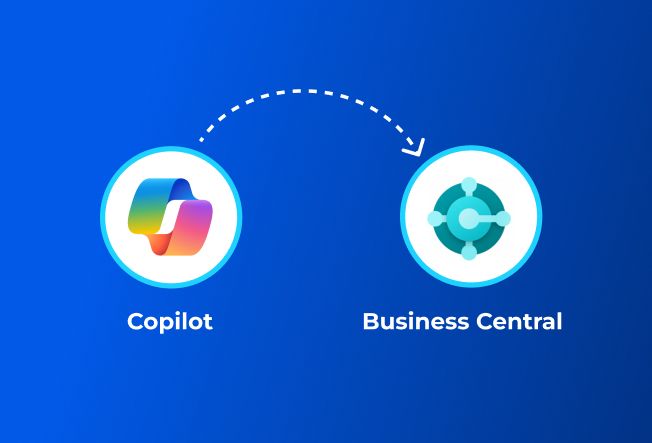Top 8 Microsoft Dynamics Customizations Beyond the Basics
Oct 06, 2023 Aiswarya Madhu
Imagine D365 as a high-performance sports car—powerful but lacking that personalized touch. However, you can elevate its prowess through Microsoft Dynamics Customizations, adding the unique features that align precisely with your business needs.
Let’s dive deep to learn how this customization in D365 works and where all you can bring modifications
On this page
Let's explore the diverse areas open for Microsoft Dynamics CRM customization:
1. Entity Customization
Customizing entities involves tailoring the data structure to align with specific business requirements. For instance, suppose a real estate company wants to include a new entity called "Properties" to track property details like location, type, and pricing within the CRM.
For example,
A company specializing in event management wants to create a new entity called "Events" to manage various event details such as event name, date, venue, expected attendees, and associated costs. Within Dynamics 365, they navigate to the customization area, select "Entities," and create a new entity named "Events." They define specific attributes like "Event Name," "Date," "Venue," and establish relationships with existing entities like "Contacts" to track attendees.
2. Form and View Customization
This level allows modifying the user interface by creating custom forms and views. For example, a sales team may need a tailored "Opportunity Form" to capture additional details specific to their sales pipeline, enhancing their decision-making process.
For example,
A healthcare organization requires a custom form for patient records within Dynamics 365. They create a new form called "Patient Details" by adding fields such as "Medical History," "Allergies," and "Prescriptions." Additionally, they design a custom view that displays patient records based on specific criteria like "Last Visit Date" or "Diagnosis Type," facilitating quick access to critical information for medical practitioners.
3. Business Process Workflow Customization
Implementing workflows and business process flows without the need for extensive technical knowledge. For instance, setting up a workflow that automates the lead nurturing process, triggering follow-up tasks based on specific lead interactions.
For example,
An insurance company aims to streamline their claims processing. They set up a workflow in Dynamics 365 that triggers when a new claim is created. This workflow automatically assigns the claim to the relevant department based on the claim type, notifies the claims handler, and sets follow-up tasks at different stages of processing until the claim is resolved.
4. Validation Rules and Business Logic Customization
Implementing validation rules ensures data integrity. For instance, setting up a rule that prevents sales representatives from closing a deal without updating the "Next Steps" field, promoting thorough customer engagement.
For example,
Within Dynamics 365, a manufacturing company dealing with customized machinery implements validation rules to streamline their order processing. They set up a rule that mandates input for critical specifications, like "Customization Details," "Technical Drawings," and "Material Preferences," ensuring comprehensive information is provided before order confirmation. This validation ensures that sales representatives cannot progress without entering these specifications, reducing errors in manufacturing and preventing delays caused by incomplete or inaccurate order information.
5. Plug-ins and Custom Code Customization
At this level, customization requires technical expertise. Developing custom plug-ins allows extending CRM functionalities. For example, creating a plug-in to integrate a third-party payment gateway for seamless invoice processing directly from the CRM interface.
For example,
An e-commerce company desires tighter integration between Dynamics 365 CRM and their online payment system. They develop a custom plug-in that triggers after a successful sale is recorded in CRM. This plug-in communicates with the payment gateway API, automatically updating the payment status in Dynamics 365, reducing manual entry and ensuring accurate financial records.
6. Web Applications and External Integrations Customization
Developing custom web applications or integrating external systems enhances CRM capabilities. For instance, integrating an inventory management system to automatically update product availability in real-time within the CRM.
For example,
A logistics company integrates an external tracking system with Dynamics 365 to provide real-time shipment updates. They develop a custom web application within Dynamics 365 that fetches data from the external tracking system, displaying live shipment statuses directly within the CRM interface, enhancing customer service and operational efficiency.
7. Device-Specific Customization
This involves tailoring the platform to ensure cross-device compatibility and optimal performance across various screen sizes. This customization focuses on optimizing layouts, functionalities, and interface elements for smartphones, tablets, and desktops. It ensures that users accessing the CRM from diverse devices experience a seamless and user-friendly interface, allowing them to interact with the system efficiently regardless of the device they use.
For example,
Let's consider a scenario where a sales team utilizes Dynamics 365 CRM on various devices. The Customization for devices ensures that regardless of the device used, the interface remains intuitive and functional. For instance, when accessed on a desktop, the CRM interface might display comprehensive dashboards with detailed analytics and larger data grids. However, when accessed on a smartphone, the interface might prioritize key information, presenting it in a more condensed and easily navigable format to suit the smaller screen size. Buttons, menus, and other elements can be optimized for touch-screen functionality on tablets and smartphones, allowing users to interact effortlessly.
8. User interface (UI) Customization
This customization goes beyond mere alterations in layout or appearance; it encompasses a strategic approach to align the CRM's look and feel with the organization's brand identity. Altering CRM interface elements allows for adjustments in color schemes, fonts, layouts, and overall visual aesthetics, ensuring a consistent and branded experience for users. This UI customization is more than just a cosmetic enhancement; it significantly influences user engagement and experience, fostering a sense of familiarity and coherence while interacting with the CRM.
For example,
Let's consider a retail company expanding its online presence and integrating Dynamics 365. To align the CRM with the brand, they embark on UI customization. They alter the CRM's default color palette, incorporating the company's signature colors across the interface. Additionally, they customize the layout to emphasize product categories, mirroring their website's navigation. By tweaking fonts and iconography to match their branding guidelines, they create a seamless visual transition for users moving between the website and the CRM.
Scale with Microsoft Dynamics 365 CRM Customization
Discover how Nalashaa Digital revolutionized a leading mortgage company's customer service using Dynamics CRM customization. From real-time dashboards to sales forecasting and omni-channel engagement, our solutions enhanced efficiency and customer relationships.
Challenges Resolved by Dynamics Customizations
Meeting Evolving Customer Expectations
In the dynamic landscape of customer expectations, businesses face the challenge of delivering personalized solutions beyond standard offerings. Microsoft Dynamics 365's Entity Customization comes to the rescue by allowing businesses to tailor data structures. This empowers organizations to track and deliver precisely what their customers seek, fostering a more personalized and satisfactory experience.
Unified Data Management
One of the critical challenges businesses encounter is the siloed nature of data, inhibiting a comprehensive understanding of information across the organization. With Microsoft Dynamics 365's Form and View Customization, this challenge is addressed by breaking down data silos. The customization provides a unified view that enhances decision-making by presenting a holistic perspective, ultimately improving operational insights.
Adoption of Modern Technologies
Businesses often grapple with the underutilization of modern tools and technologies, hindering operational efficiency. Microsoft Dynamics 365's Business Process Workflow Customization steps in to automate workflows, seamlessly integrating modern tools. This enhances efficiency, streamlines operations, and allows organizations to fully embrace technological advancements.
Enhanced Decision-making through Insights
Decision-makers often struggle to derive meaningful insights from the vast pool of data available. Microsoft Dynamics 365's Validation Rules and Business Logic Customization address this challenge by ensuring data accuracy. This provides decision-makers with reliable information for strategic decision-making, reducing the margin of error in critical choices.
Improving Data Quality and Compliance
Maintaining high data quality and compliance with industry regulations is a constant challenge. Microsoft Dynamics 365's Plug-ins and Custom Code Customization establish stringent rules, preserving data integrity. This ensures compliance with regulatory standards, creating a foundation for secure and reliable operations.
Seamless Integration for Increased Productivity
Productivity often suffers due to disjointed systems and manual processes. Microsoft Dynamics 365's Web Applications and External Integrations Customization comes to the rescue by connecting external systems. This enables real-time updates and fosters a streamlined workflow, significantly boosting overall productivity.
Customizing Dynamics 365 to Organizational Needs
Standard CRM configurations sometimes fall short of aligning with specific organizational requirements. Microsoft Dynamics 365's Device-Specific Customization ensures cross-device compatibility. It offers a tailored user experience that meets unique organizational needs, optimizing interactions and user engagement.
Simplifying Customer Management
The complexity or unintuitive nature of a user interface can hinder customer interactions. Microsoft Dynamics 365's User Interface (UI) Customization enhances the CRM's look and feel. This makes it more intuitive, user-friendly, and aligned with the organization's branding. The result is a seamless and engaging customer management experience.
Key Criteria Checklist for Selecting Microsoft Dynamics Customization Partner
| Key Criteria Checklist | Nalashaa |
|---|---|
| Assess Your Company's Needs | |
| - Identify specific customization requirements | |
| - Determine areas for process improvement | |
| Evaluate Partner Expertise | |
| - Verify proficiency in Customization | |
| - Assess experience with similar industry requirements | |
| Ensure Data Security and Accessibility | |
| - Validate a robust security infrastructure | |
| - Ensure accessibility and availability of data | |
| Examine User Experience Enhancement | |
| - Check track record in improving user experience | |
| - Evaluate solutions for intuitive and user-friendly interfaces | |
| Explore Scalability and Efficiency | |
| - Assess capabilities to enhance scalability and operational efficiency | |
| - Ensure adaptability to accommodate future business growth | |
| Simplify Customer Management | |
| - Confirm expertise in streamlining customer communication and management processes | |
| - Evaluate tools and strategies for efficient customer relationship management (CRM) | |
| Review Client Testimonials and References | |
| - Check for positive feedback and success stories from previous clients | |
| - Request references to validate the partner's reputation and performance | |
| Cost-Effective Solutions | |
| - Analyze the cost structure and ensure transparency in pricing models | |
| - Verify that the proposed solutions align with your budget constraints |
Explore the guide to choose the ideal Microsoft Dynamics 365 support partner. Gain insights on key criteria for an informed decision.
Is Customization Same as D365 Configuration?
Understanding the nuances between Microsoft Dynamics Customizations and configuration is crucial for maximizing the potential of your CRM system. While both are integral to refining your Microsoft Dynamics 365 experience, they operate in distinct realms. Let's delve into a detailed comparison to understand how customization in Dynamics 365 and configuration each contribute uniquely to optimizing your CRM solution.
| Customization in Microsoft Dynamics 365 CRM | Configuration in Microsoft Dynamics 365 CRM |
|---|---|
| In Dynamics 365, customization involves crafting and integrating bespoke CRM features that are specifically designed to meet the unique needs and requirements of your business and users. This process can be facilitated by engaging a Microsoft D365 partner, leveraging specialized tools and technologies for customized solutions. This includes functionalities like app and function builders, workflow automation, and simple dashboard design. Some of the latest capabilities encompass Power Suite, Common Data Service (CDS), and Common Data Model (CDM). | Configuration services in Dynamics CRM revolve around enhancing the UI design, field settings, security measures, business rules, and utilization of various options and features available within the Microsoft Dynamics 365 configuration solution. |
Bottom Line
Dive into the realm of Microsoft Dynamics Customization with Nalashaa Digital, your reliable partner on the journey from raw data to meaningful engagements. As a trusted Dynamics 365 ally, we go beyond understanding the intricacies of CRM customization; we redefine them. Our expertise lies in seamlessly weaving tailored solutions, empowering businesses not only to meet but to surpass customer expectations.
Recent Posts

Dynamics 365 On Premise to Cloud Migration [Everything You Need to Know]
Oct 16, 2024

From Horizontal to Vertical CRM [Is Dynamics 365 the Ideal Fit?]
Sep 03, 2024

Copilot in Business Central [Top 16 Questions Answered]
Aug 13, 2024
Category
Our Expertise
About Author

Aiswarya Madhu
In the ever-changing tech landscape, my mission is to craft content that simplifies complex concepts and brings the wonders of modern technology closer to my audience. With a rich experience spanning over 2 years, I have honed my skills in crafting captivating and informative content for B2B domain that deeply resonates with the tech-savvy audience. When not working, you'll often find me with a steaming cup of tea and an inspiring book, fueling my curiosity and passion for knowledge.
Never Miss News
Want to implement Dynamics 365?
We have plans which will meet your needs, and if not we can tweak them around a bit too!


